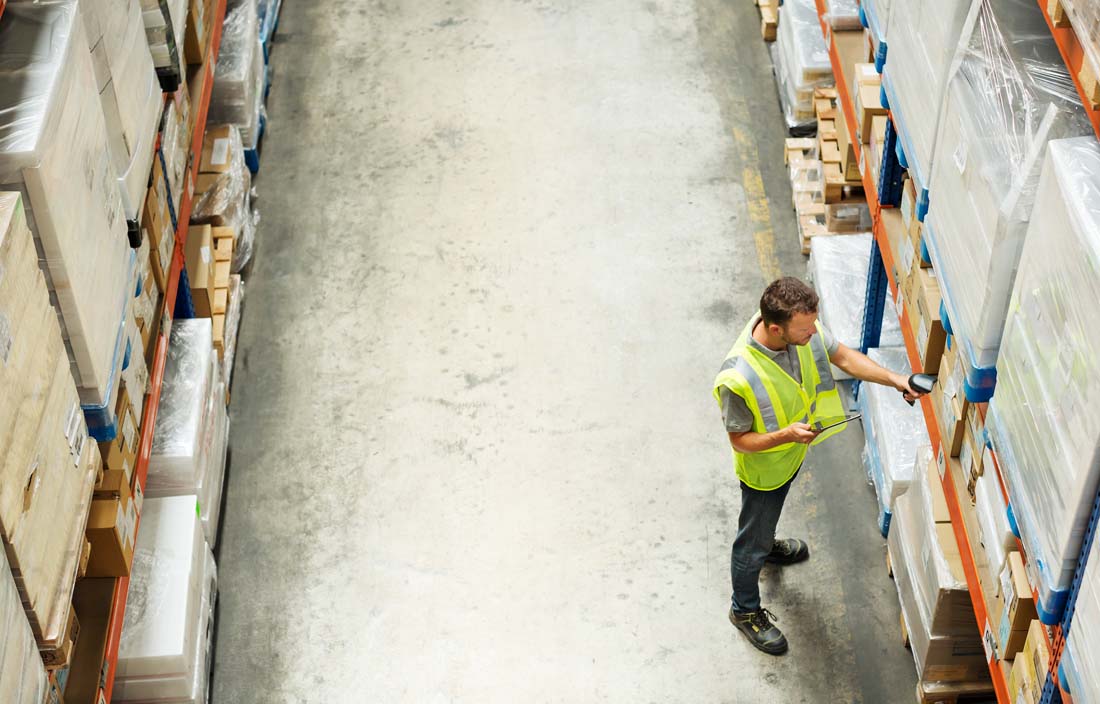Blockchain means business: Is your organization ready?

We named blockchain a “trend to watch,” and for good reason: the blockchain market is expected to surge from $4.9 billion in 2021 to $67.4 billion by 2026. While the COVID-19 pandemic and the global supply chain chaos that followed are driving much of this growth, public and private sectors are discovering the real value in what was once dismissed as merely “bitcoin tech.”
Today’s supply chains are global networks of manufacturers, suppliers, logistics companies, and more — each with its own enterprise resource planning (ERP) or manual systems, paper-based contracts, and disparate processes with little or no common standards. This disjointed ecosystem results in information silos, making product tracking inefficient and time-consuming. Lack of traceability and transparency leads to costly delays and errors.
Blockchain addresses these challenges by acting as a shared digital ledger. It creates a single source of truth across a supply chain network and lets all participants view and securely validate transactions. As a result, it helps eliminate silos and creates complete, real-time, end-to-end transparency within supply chains. Global automotive and manufacturing players like Toyota and Walmart initially led the way, but now healthcare, government, and real estate sectors are also starting to capitalize on blockchain’s unique capabilities. Consider the following examples of how blockchain can augment or replace existing systems and processes.
Blockchain creates a single source of truth across a supply chain network, and lets all participants view and securely validate transactions.
Smart contracts
A smart contract is a set of codes built over the blockchain infrastructure that specifies pre-agreed-upon terms and conditions between two parties. Once the terms and conditions have been validated in real-time, it triggers an automatic transaction — for example, a payment is generated when a shipment of parts reaches its destination on time and meets agreed-upon quality standards. Since smart contracts are merely coded requirements, they can also be used in service-based sectors for a wide range of data transactions, payment processes, quality validations, and more. Insurance providers can use them to manage medical contracts for patients; landlords can use smart contracts to prevent disagreements about rental terms and conditions; and counties can use them to transfer property deeds and titles or to manage land records.
Smart contracts also have clear benefits for supply chain managers. They remove any uncertainty about which version of a contract the parties are held to; reduce delays caused by payment approval hierarchy; eliminate processing times for orders and payments; and automatically create a comprehensive audit trail. Smart contracts become even more powerful when paired with internet of things (IoT) technology. For example, GPS-based RFID sensors can enhance a company’s visibility to track and trace precisely where and when goods are moving through the supply chain. They can also alert parties in the smart contract if manual intervention is needed: for example, if an IoT device detects a broken seal or an open container in a shipment, it can alert parties in real time to investigate. This not only reduces supply risk and prevents a compromised product from traveling further upstream — it also enables a manufacturer to isolate and address only the affected item, rather than pulling an entire shipment offline.
Inventory traceability
There are a variety of inventory traceability considerations for blockchain:
- International regulations. The global supply chain is composed of multiple intersecting supply chains, which can make it difficult for individual suppliers to gather data. Using blockchain as a tool to see into transactions taking place prior to your company’s supply chain can help. Country of origin, for example, is valuable information that could be collected to support regulatory requirements such as conflict material reporting. Tapping into the blockchain also would allow suppliers to use electronic data for compliance with import/export rules and regulations.
- Purchasing. Blockchain can also enable suppliers to obtain real-time data for movement of materials and goods. The information could be used in conjunction with ERP software to update inventory planning. With more realistic and reliable delivery dates, resource planning and scheduling functions improve significantly, with very little user interaction. This would reduce data entry errors and miscommunication between supplier and manufacturer. Cross-border payments would eliminate the middleman and reduce overall costs.
- Distribution. Logistics has become the proving ground for the blockchain concept. By collecting temperature, location, and other vital data along the supply chain, traceability, quality control, and early detection of problems all improve. Shipping giants FedEx and DHL have embraced blockchain-backed logistics, using it to keep a digital ledger of shipments and maintain integrity of transactions.
By collecting temperature, location, and other vital data along the supply chain, traceability, quality control, and early detection of problems all improve.
Accountability
Blockchain can improve supply chain accountability in meaningful ways:
- Provenance. Blockchain can be used to pinpoint and authenticate the origin of goods. In the automotive sector, manufacturers and suppliers can use provenance of parts to confirm authenticity and ensure that end customers purchase a safe, reliable product. For example, blockchain technology guarantees that a Toyota hood on a Camry came from a certified Toyota supplier rather than an illegitimate part supplier. EV manufacturers such as Volvo are exploring a new twist on provenance by using data in the blockchain to trace cobalt’s origin, verify its chain of custody, and record information establishing that participants comply with all supply chain guidelines.
- Product life cycle management. Blockchain can enable all parties to access verified information throughout the life of a product. For example, an auto manufacturer could have the serial numbering and related bills of material used during manufacture, along with all related configurations, recorded on the blockchain. Logistics moves the product to a distribution location, with additional data collected along the way. The product is received; payment is automatically processed; the consumer purchases from the distributor; and the blockchain is updated with transfer of ownership.
In the healthcare sector, blockchain can serve the vital function of ensuring provenance of drugs and medical equipment. By creating a single, infallible record of each individual product from its point of origin (i.e., a manufacturing plant), blockchain can prevent counterfeit drugs from entering the supply chain and enable pharmaceutical companies to issue highly targeted recalls of specific lots or batches of drugs as needed.
The Mobility Open Blockchain Initiative, a consortium that includes automakers like GM, Ford, BMW, and Honda, is working on an initiative to bring this vision to life. Its Vehicle Identity (VID) Standard would create “birth certificates” for vehicles, tracing maintenance history and vehicle registration even across borders in a shared ledger. In the event of a service bulletin, data would be accessed from the blockchain and the appropriate consumers could be notified.
Data protection
As with any major technology disruptor, blockchain risks do exist. The integration of blockchain within a supply chain allows for the possibility of complete end-to-end visibility, from suppliers to manufacturers and distributors to end customers, and this “wide-open” view raises some security concerns. Private blockchain addresses these concerns by restricting records to a defined group, such as primary members in a specific supply chain or industry. Traditional security methods, such as access control lists, user rights, or data encryption, protect the data.
Perhaps counterintuitively, some see blockchain as a means of making the digital world safer. Pandemic trends and distributed IT environments have made organizations more susceptible to privacy concerns, further fueling the exploration of blockchain’s ability to verify and protect data. In the healthcare sector — where patient privacy is paramount and protected by law — blockchain could create a single source of truth and a single holistic view of the patient’s medical record. Medical providers and insurance agencies could gain safe and immediate access to up-to-date patient data, while patients themselves could grant access to specific family members or advocates for a specified amount of time.
Manufacturers that use IoT are also taking note of blockchain’s security advantages. The increased adoption of IoT devices provides new entry points for cybercriminals to launch DDoS and botnet attacks and to breach insecure ecosystem interfaces. Blockchain-infused IoT adds a higher level of security, preventing data breaches by applying transparency and virtual incorruptibility of the technology to keep “smart” devices safe. This enables manufacturers to trust performance data from their IoT-enabled machinery and reap the benefits of proactive, preventative maintenance.
Blockchain-infused IoT adds a higher level of security, preventing data breaches by applying transparency and virtual incorruptibility of the technology to keep “smart” devices safe.
The future of blockchain
As innovative technology firms, global organizations, and governing agencies map out the future of blockchain, it will continue to change the nature of how the public and private sectors conduct business. Many large manufacturers, government agencies, and medical systems are already making significant investments to understand the opportunities and proactively harness blockchain’s capabilities. Forward-thinking suppliers and service firms that intend to grow and thrive will need to do the same.




